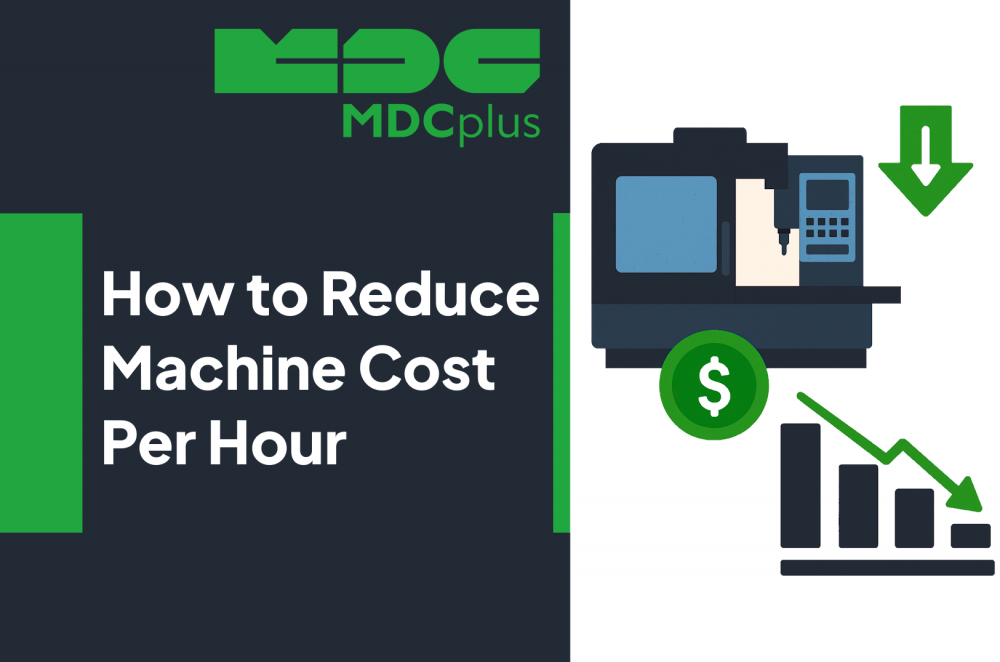Next level production control
Get started with your projectHow to Reduce Machine Cost Per Hour
In manufacturing margins are often measured in fractions. And few numbers are as consequential or misunderstood as machine cost per hour. This single metric encapsulates the real cost of owning, operating, and maintaining equipment over time so let's learn more about it.
Whether you’re running a CNC shop, injection molding facility, or a mixed-use line, reducing your machine cost per hour can deliver substantial savings without compromising quality or output. Here's how to do it, strategically and sustainably.
What Is Machine Cost Per Hour?
At its core, machine cost per hour is the total hourly cost of operating a machine, including:
- Depreciation (capital cost over time)
- Energy consumption
- Maintenance and repair
- Tooling and consumables
- Labor (if machine-tied)
- Floor space (pro-rated facility costs)
Reducing this cost doesn’t mean cutting corners. It means getting more value from every minute your machine runs.
1. Increase Utilization: Don’t Let Machines Sit Idle
Idle machines are silent cost centers. If a $500,000 machine runs only 20 hours a week, your effective hourly cost skyrockets.
Strategies:
- Reduce changeover time: Implement SMED (Single-Minute Exchange of Dies) methods to minimize setup.
- Cross-train operators: Eliminate downtime due to personnel constraints.
- Implement real-time monitoring: Tools like MDC (Machine Data Collection) software can expose hidden idle time and unlock scheduling gains.
More runtime = lower hourly cost without touching your pricing or payroll.
2. Extend Tool Life and Reduce Consumables Waste
Tooling and consumables can quietly lower profit margins.
Strategies:
- Use condition monitoring: Detect wear early and replace only when needed.
- Optimize cutting parameters: Use the right feeds and speeds to prevent premature tool wear.
- Invest in quality: High-end tools may cost more upfront but often last longer and reduce scrap.
3. Cut Energy Waste
Energy costs are often overlooked in hourly machine rates—but they add up quickly.
Strategies:
- Schedule heavy-load processes during off-peak hours (if energy rates vary).
- Use smart automation: Power down auxiliary systems automatically during idle periods.
- Upgrade inefficient motors or air systems: ROI on energy-efficient retrofits can be surprisingly quick.
4. Preventive Maintenance Over Crisis Repair
Reactive maintenance is costly not just in repair bills, but in lost production time.
Strategies:
- Implement a preventive maintenance (PM) schedule based on actual usage, not calendar time.
- Log downtime causes: Identify repeat offenders and root causes.
- Invest in predictive analytics: Vibration, thermal, or oil analysis can help you predict failures before they happen.
Healthy machines run longer, better, and cheaper.
5. Right-Size Your Machine for the Job
Using a large, complex machine for simple parts is like commuting in a cargo truck—it’s overkill.
Strategies:
- Match machines to part complexity and material: Avoid using 5-axis for 2-axis needs.
- Consider job batching: Combine similar operations to streamline runtime.
- Invest in flexible, multipurpose machines for lower volume or job-shop environments.
6. Automate Repetitive or Manual Steps
Automation doesn’t have to mean full robotic lines. Even partial automation—like bar feeders, pallet changers, or in-machine probing—can pay dividends.
Gains:
- Reduces operator burden
- Shrinks cycle times
- Enables more lights-out manufacturing
Every hour the machine runs without human intervention is cheaper, more productive time.
7. Track It. Then Improve It.
You can’t reduce what you don’t measure. Surprisingly, many shops don’t have a clear view of their true machine cost per hour.
Start by:
- Calculating all overhead costs tied to machine ownership
- Monitoring runtime and downtime by machine
- Reviewing historical job costing for accuracy
Modern MDC systems, paired with ERP or cost estimation software, can provide this insight in real time.
Precision Isn’t Just for Parts
Reducing machine cost per hour isn’t about slashing budgets or cutting corners. It’s about precision thinking applied to your operation, just like you apply it to the parts you make.
With smart monitoring, disciplined maintenance, and strategic investment, manufacturers can turn machines into not just assets but profit centers.
About MDCplus
Our key features are real-time machine monitoring for swift issue resolution, power consumption tracking to promote sustainability, computerized maintenance management to reduce downtime, and vibration diagnostics for predictive maintenance. MDCplus's solutions are tailored for diverse industries, including aerospace, automotive, precision machining, and heavy industry. By delivering actionable insights and fostering seamless integration, we empower manufacturers to boost Overall Equipment Effectiveness (OEE), reduce operational costs, and achieve sustainable growth along with future planning.
Ready to increase your OEE, get clearer vision of your shop floor, and predict sustainably?
